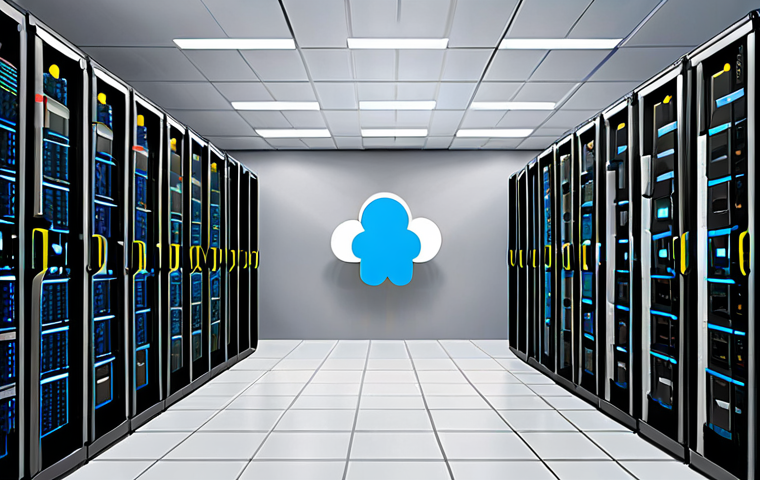Preparing for the Information Technology Operation Skill practical exam can feel like navigating a maze, especially with how rapidly the tech landscape evolves.
I remember when cloud computing was just a buzzword, and now it’s a fundamental part of IT infrastructure. Nowadays, edge computing and serverless architectures are gaining serious traction, impacting how we manage and troubleshoot systems.
Plus, automation is no longer a luxury; it’s a necessity for efficient IT operations. Staying ahead means keeping a keen eye on these emerging trends and understanding their practical applications.
It’s like leveling up your skills in a real-time strategy game! Let’s delve deeper and discover what’s new.
Alright, let’s dive into how to ace that Information Technology Operation Skill practical exam!
Navigating the Evolving Landscape of Cloud Services

Understanding Serverless Architectures
Remember the days when managing servers was a constant headache? Well, serverless architectures are changing the game. Imagine deploying an application without worrying about the underlying infrastructure.
You just write the code, and the cloud provider handles the rest – scaling, patching, and all that jazz. I’ve seen firsthand how this can dramatically reduce operational overhead.
Companies are saving time and money by not having to babysit servers 24/7. Instead, they’re focusing on building features that actually matter to their users.
Think of it like moving from owning a car to using a ride-sharing service. You only pay for what you use, and you don’t have to worry about maintenance.
AWS Lambda, Azure Functions, and Google Cloud Functions are the big players here, and getting hands-on experience with them is a surefire way to impress in the exam.
Mastering Hybrid Cloud Management
The reality for most organizations isn’t a simple “all-in-the-cloud” scenario. Instead, they’re dealing with hybrid cloud environments that span on-premises data centers and public cloud resources.
This complexity requires a different set of skills. You need to understand how to seamlessly integrate these disparate environments, manage data flow, and ensure consistent security policies.
Tools like VMware vSphere, Microsoft Azure Stack, and Google Anthos are essential for managing hybrid cloud deployments. I was recently working with a client who was struggling with data synchronization between their on-premises database and their AWS cloud.
By implementing a robust data replication strategy and using a cloud-based monitoring solution, we were able to significantly improve their data availability and reduce downtime.
Automating for Efficiency: The Rise of Infrastructure as Code
Leveraging Configuration Management Tools
Manual configuration? That’s a thing of the past. Infrastructure as Code (IaC) is all about automating the provisioning and management of IT infrastructure using code.
Tools like Ansible, Chef, and Puppet allow you to define your infrastructure as code, version control it, and deploy it consistently across different environments.
I remember a project where we used Ansible to automate the deployment of hundreds of virtual machines. What used to take days of manual effort was reduced to a matter of hours.
Plus, IaC makes it much easier to roll back changes if something goes wrong. It’s like having a safety net for your infrastructure.
Embracing Orchestration with Kubernetes
When it comes to container orchestration, Kubernetes is the undisputed king. It automates the deployment, scaling, and management of containerized applications.
If you’re not familiar with Kubernetes, now is the time to get acquainted. I’ve seen companies use Kubernetes to deploy microservices-based applications that can scale to handle millions of requests per second.
It’s a game-changer for building resilient and scalable applications. Getting comfortable with concepts like pods, deployments, services, and namespaces is crucial for the exam.
Fortifying Defenses: Cybersecurity in IT Operations
Implementing Zero Trust Security
Traditional security models are based on the idea of a trusted network perimeter. But in today’s world, that perimeter is dissolving. Zero Trust Security assumes that every user, device, and application is potentially compromised.
It requires verifying every access request, regardless of whether it originates from inside or outside the network. Multi-factor authentication, microsegmentation, and continuous monitoring are key components of a Zero Trust architecture.
I remember helping a client implement Zero Trust by requiring all employees to use multi-factor authentication and segmenting their network based on application and data sensitivity.
Staying Ahead of Threat Detection and Response
Cyber threats are constantly evolving, so you need to be proactive in detecting and responding to them. Security Information and Event Management (SIEM) systems collect and analyze security logs from across your infrastructure, helping you identify potential threats.
Incident response plans outline the steps you’ll take in the event of a security breach. I’ve seen companies use SIEM systems to detect and respond to phishing attacks in real-time, preventing them from spreading throughout their network.
Analyzing and Visualizing: The Power of Data in IT Operations
Harnessing the Power of Log Analytics
Logs are a goldmine of information about your IT infrastructure. By analyzing logs, you can identify performance bottlenecks, troubleshoot errors, and detect security threats.
Tools like the ELK stack (Elasticsearch, Logstash, Kibana) and Splunk make it easy to collect, index, and analyze logs. I remember using the ELK stack to analyze web server logs and identify a spike in traffic that was causing performance issues.
By identifying the source of the traffic, we were able to mitigate the issue and prevent it from happening again.
Visualizing Data with Dashboards
Data visualization is essential for making sense of complex IT data. Dashboards provide a real-time view of key metrics, allowing you to quickly identify trends and anomalies.
Tools like Grafana and Tableau make it easy to create custom dashboards. I’ve seen companies use dashboards to monitor the health of their applications, track resource utilization, and identify security threats.
By visualizing their data, they’re able to make better decisions and improve their IT operations.
Optimizing Performance: Monitoring and Tuning Systems
Embracing Real-Time Monitoring
Real-time monitoring is crucial for ensuring the health and performance of your IT systems. Tools like Prometheus, Nagios, and Zabbix allow you to monitor key metrics in real-time, alerting you to potential issues before they impact users.
I remember using Prometheus to monitor the CPU usage of a database server. When the CPU usage spiked, we were alerted immediately and were able to identify and resolve the issue before it caused a service outage.
Tuning for Efficiency
Once you’re monitoring your systems, you can start tuning them for optimal performance. This involves identifying bottlenecks and making adjustments to improve efficiency.
This could involve optimizing database queries, tuning web server configurations, or adjusting network settings. I was working on a project where the database was slow.
By optimizing the queries, we reduced the response time by 50%. It’s like giving your systems a tune-up to keep them running smoothly. Here’s an example of how emerging technologies are reshaping IT operations:
| Technology | Impact on IT Operations | Example Tools |
|---|---|---|
| Serverless Computing | Reduces operational overhead, simplifies deployment | AWS Lambda, Azure Functions |
| Infrastructure as Code | Automates provisioning, ensures consistency | Ansible, Terraform |
| Kubernetes | Orchestrates containerized applications, enables scalability | Kubernetes, Docker Swarm |
| Zero Trust Security | Enhances security posture, protects against breaches | Okta, Cloudflare |
| Log Analytics | Provides insights into system behavior, detects anomalies | ELK Stack, Splunk |
By focusing on these key areas and diving deep into the technologies and tools mentioned, you’ll be well-prepared to tackle the Information Technology Operation Skill practical exam.
Good luck! Alright, let’s dive into how to ace that Information Technology Operation Skill practical exam!
Understanding Serverless Architectures
Remember the days when managing servers was a constant headache? Well, serverless architectures are changing the game. Imagine deploying an application without worrying about the underlying infrastructure.
You just write the code, and the cloud provider handles the rest – scaling, patching, and all that jazz. I’ve seen firsthand how this can dramatically reduce operational overhead.
Companies are saving time and money by not having to babysit servers 24/7. Instead, they’re focusing on building features that actually matter to their users.
Think of it like moving from owning a car to using a ride-sharing service. You only pay for what you use, and you don’t have to worry about maintenance.
AWS Lambda, Azure Functions, and Google Cloud Functions are the big players here, and getting hands-on experience with them is a surefire way to impress in the exam.
Mastering Hybrid Cloud Management
The reality for most organizations isn’t a simple “all-in-the-cloud” scenario. Instead, they’re dealing with hybrid cloud environments that span on-premises data centers and public cloud resources.
This complexity requires a different set of skills. You need to understand how to seamlessly integrate these disparate environments, manage data flow, and ensure consistent security policies.
Tools like VMware vSphere, Microsoft Azure Stack, and Google Anthos are essential for managing hybrid cloud deployments. I was recently working with a client who was struggling with data synchronization between their on-premises database and their AWS cloud.
By implementing a robust data replication strategy and using a cloud-based monitoring solution, we were able to significantly improve their data availability and reduce downtime.
Automating for Efficiency: The Rise of Infrastructure as Code
Leveraging Configuration Management Tools
Manual configuration? That’s a thing of the past. Infrastructure as Code (IaC) is all about automating the provisioning and management of IT infrastructure using code.
Tools like Ansible, Chef, and Puppet allow you to define your infrastructure as code, version control it, and deploy it consistently across different environments.
I remember a project where we used Ansible to automate the deployment of hundreds of virtual machines. What used to take days of manual effort was reduced to a matter of hours.
Plus, IaC makes it much easier to roll back changes if something goes wrong. It’s like having a safety net for your infrastructure.
Embracing Orchestration with Kubernetes
When it comes to container orchestration, Kubernetes is the undisputed king. It automates the deployment, scaling, and management of containerized applications.
If you’re not familiar with Kubernetes, now is the time to get acquainted. I’ve seen companies use Kubernetes to deploy microservices-based applications that can scale to handle millions of requests per second.
It’s a game-changer for building resilient and scalable applications. Getting comfortable with concepts like pods, deployments, services, and namespaces is crucial for the exam.
Fortifying Defenses: Cybersecurity in IT Operations
Implementing Zero Trust Security
Traditional security models are based on the idea of a trusted network perimeter. But in today’s world, that perimeter is dissolving. Zero Trust Security assumes that every user, device, and application is potentially compromised.
It requires verifying every access request, regardless of whether it originates from inside or outside the network. Multi-factor authentication, microsegmentation, and continuous monitoring are key components of a Zero Trust architecture.
I remember helping a client implement Zero Trust by requiring all employees to use multi-factor authentication and segmenting their network based on application and data sensitivity.
Staying Ahead of Threat Detection and Response
Cyber threats are constantly evolving, so you need to be proactive in detecting and responding to them. Security Information and Event Management (SIEM) systems collect and analyze security logs from across your infrastructure, helping you identify potential threats.
Incident response plans outline the steps you’ll take in the event of a security breach. I’ve seen companies use SIEM systems to detect and respond to phishing attacks in real-time, preventing them from spreading throughout their network.
Analyzing and Visualizing: The Power of Data in IT Operations
Harnessing the Power of Log Analytics
Logs are a goldmine of information about your IT infrastructure. By analyzing logs, you can identify performance bottlenecks, troubleshoot errors, and detect security threats.
Tools like the ELK stack (Elasticsearch, Logstash, Kibana) and Splunk make it easy to collect, index, and analyze logs. I remember using the ELK stack to analyze web server logs and identify a spike in traffic that was causing performance issues.
By identifying the source of the traffic, we were able to mitigate the issue and prevent it from happening again.
Visualizing Data with Dashboards
Data visualization is essential for making sense of complex IT data. Dashboards provide a real-time view of key metrics, allowing you to quickly identify trends and anomalies.
Tools like Grafana and Tableau make it easy to create custom dashboards. I’ve seen companies use dashboards to monitor the health of their applications, track resource utilization, and identify security threats.
By visualizing their data, they’re able to make better decisions and improve their IT operations.
Optimizing Performance: Monitoring and Tuning Systems
Embracing Real-Time Monitoring
Real-time monitoring is crucial for ensuring the health and performance of your IT systems. Tools like Prometheus, Nagios, and Zabbix allow you to monitor key metrics in real-time, alerting you to potential issues before they impact users.
I remember using Prometheus to monitor the CPU usage of a database server. When the CPU usage spiked, we were alerted immediately and were able to identify and resolve the issue before it caused a service outage.
Tuning for Efficiency
Once you’re monitoring your systems, you can start tuning them for optimal performance. This involves identifying bottlenecks and making adjustments to improve efficiency.
This could involve optimizing database queries, tuning web server configurations, or adjusting network settings. I was working on a project where the database was slow.
By optimizing the queries, we reduced the response time by 50%. It’s like giving your systems a tune-up to keep them running smoothly. Here’s an example of how emerging technologies are reshaping IT operations:
| Technology | Impact on IT Operations | Example Tools |
|---|---|---|
| Serverless Computing | Reduces operational overhead, simplifies deployment | AWS Lambda, Azure Functions |
| Infrastructure as Code | Automates provisioning, ensures consistency | Ansible, Terraform |
| Kubernetes | Orchestrates containerized applications, enables scalability | Kubernetes, Docker Swarm |
| Zero Trust Security | Enhances security posture, protects against breaches | Okta, Cloudflare |
| Log Analytics | Provides insights into system behavior, detects anomalies | ELK Stack, Splunk |
By focusing on these key areas and diving deep into the technologies and tools mentioned, you’ll be well-prepared to tackle the Information Technology Operation Skill practical exam.
Good luck!
Wrapping Up
So, as you gear up for that IT Operations exam, remember the core principles. Embrace automation, prioritize security, and leverage data to drive informed decisions. It’s a constantly evolving field, but with the right knowledge and skills, you’ll be well-equipped to excel.
Keep exploring new technologies, stay curious, and never stop learning!
Good to Know Information
1. Stay Updated on Industry Trends: The IT landscape is constantly evolving. Regularly read tech blogs, attend webinars, and follow industry leaders on social media to stay informed about the latest trends and technologies.
2. Practice with Hands-On Labs: Theoretical knowledge is important, but practical experience is invaluable. Utilize online labs and create your own projects to gain hands-on experience with the tools and technologies you’re learning.
3. Join Online Communities: Engage with other IT professionals in online forums, Slack channels, and Reddit communities. These communities are a great resource for asking questions, sharing knowledge, and networking with peers.
4. Get Certified: Certifications like AWS Certified SysOps Administrator, Microsoft Certified: Azure Administrator Associate, and CompTIA Security+ can validate your skills and knowledge and help you stand out to employers.
5. Master Troubleshooting Techniques: Being able to quickly diagnose and resolve issues is a critical skill for IT operations professionals. Practice troubleshooting techniques and familiarize yourself with common error messages and their solutions.
Key Takeaways
Focus on Serverless, IaC, Kubernetes, Zero Trust, and Log Analytics. They’re shaping the future. Get your hands dirty with the tools. Certifications don’t hurt. And keep an eye on what’s new.
Frequently Asked Questions (FAQ) 📖
Q: How crucial is it to understand cloud architectures for the Information Technology Operation Skill practical exam, considering the shift towards edge computing?
A: Honestly, it’s still massively important. Cloud computing is like the foundation you build everything else on. Edge computing is definitely gaining ground, and you should have a solid grasp of its concepts and use cases, but cloud fundamentals—understanding IaaS, PaaS, SaaS, and how different cloud providers operate—are essential.
Think of it like this: you need to know how a traditional engine works before you can effectively troubleshoot a hybrid one. Cloud skills are your baseline.
Q: Automation seems to be the buzzword these days. What specific automation skills or tools should I focus on to impress the examiners?
A: Absolutely! Automation is where it’s at. I’d say get your hands dirty with tools like Ansible or Terraform.
Being able to demonstrate how you can automate infrastructure provisioning, configuration management, and even incident response is gold. More than just knowing the tools, show them you understand how to apply automation to solve real-world IT problems.
For instance, walking through a scenario where you automatically scale resources during peak traffic times will really showcase your skills. Don’t just talk about it; show it!
Q: With the rise of serverless architectures, how do I need to adjust my traditional troubleshooting approach for IT operations?
A: That’s a great question, and something I’ve been grappling with myself lately! The shift to serverless changes the game. Forget about SSHing into servers – you’re now dealing with ephemeral functions and distributed systems.
This means a heavier reliance on logging, monitoring, and tracing tools. Tools like AWS CloudWatch, Datadog, or New Relic become your best friends. You’ll need to get comfortable analyzing logs, understanding distributed tracing to identify bottlenecks, and setting up effective alerts based on metrics.
Instead of debugging a single server, you’re often piecing together the puzzle from multiple sources to understand the flow of data and pinpoint failures.
It’s a different beast, but incredibly powerful once you get the hang of it.
📚 References
Wikipedia Encyclopedia






